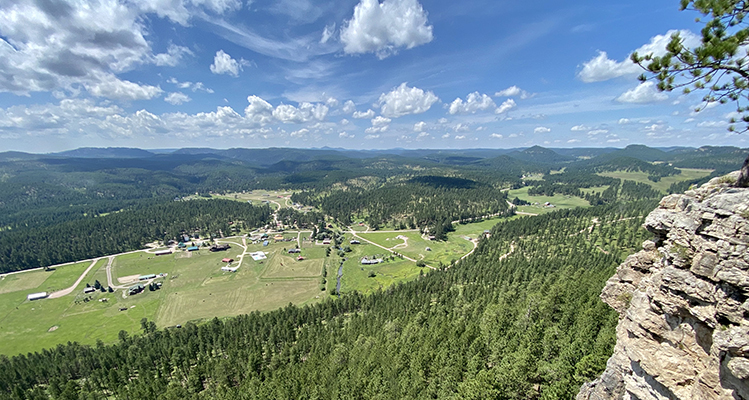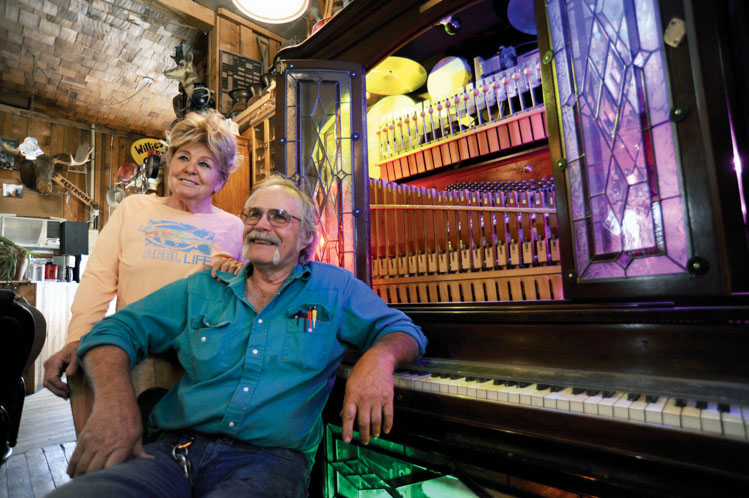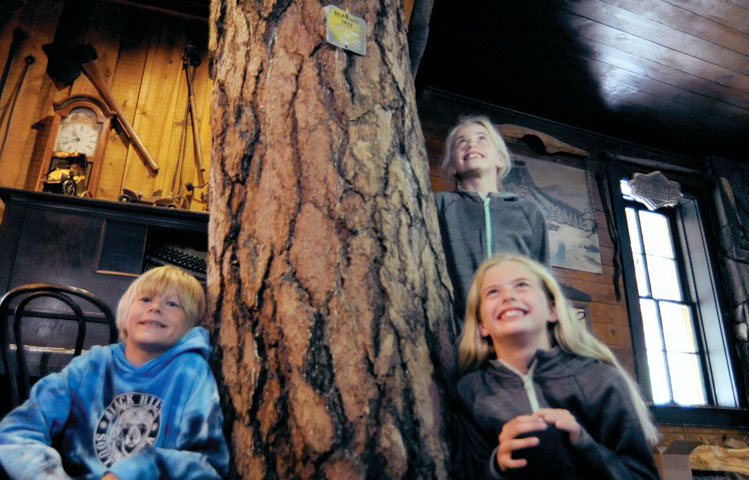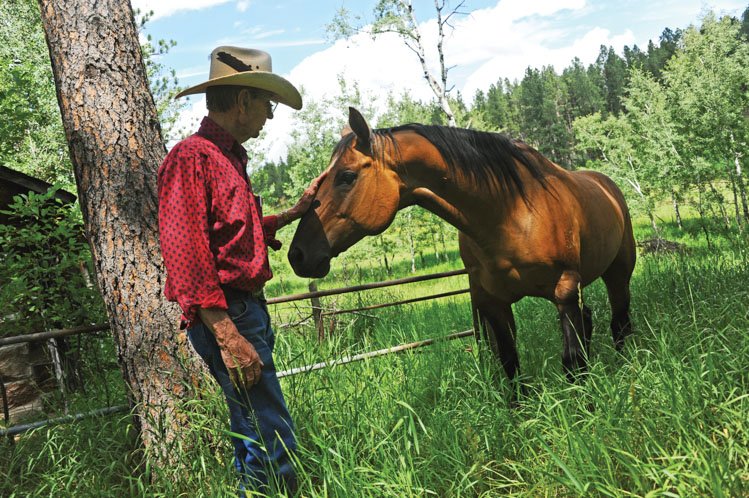The Gift of South Dakota
Subscriptions to South Dakota Magazine make great gifts!
Subscribe today — 1 year (6 issues) is just $29!
The Nemo Life
 |
| The view from atop Nemo Mountain, also called The Big Hill by old-timers, illustrates how the old logging town is buried in the Black Hills National Forest. Photo by Stephen Gassman. |
Troy Saye was already growing weary of Las Vegas when he saw the player piano in storage at the Excalibur. He’d spent years on The Strip, building stage sets for big shows like Siegfried & Roy and King Arthur’s Tournament. But the crowds and the traffic were becoming too much for a man who’d grown up on a ranch in rural Montana, the son of a rodeo calf roper.
“Eventually Dad got too old for rodeo so he moved us to Las Vegas when I was 10,” says Saye, adding that it seems like a long time ago. “I was there 42 years one weekend!”
He was stage manager at the Stardust, and then became a fixture at the theater department of the University of Nevada-Las Vegas. He was working as the “head of props” at the Excalibur when he first saw the unusual old piano that had been relegated to storage. He learned that it had once been part of the décor for a German-themed restaurant.
The coin-operated attraction wasn’t just another player piano with a keyboard. It featured an entire orchestra — drums, cymbals, flutes, a horn and tambourine all playing in unison and glowing in colored lights. Saye had an itch to buy it, though he had no idea for what, and the casino management didn’t know if they wanted to sell. Then, suddenly, the unusual piano was listed on an employee auction site. Saye was busy on auction day, but he quickly offered $350 and asked a friend to keep an eye on the bidding. Soon, someone upped it to $500.
“Pay whatever it takes,” Saye told his friend. Then he worried all day about whether his friend was successful, and if so, what the piano was going to cost him — and what he would do with it if he got it.
 |
| Troy and Willie Saye, proprietors of the Guest Ranch, are determined to preserve Nemo's history. "That's what people seem to like," Troy says. |
Long before the piano auction, Saye and his wife, Willie, had been looking for a simpler place to live. They thought it might be interesting to run a resort, and pondered lake properties in Willie’s home state of Minnesota, though Troy wasn’t sure he wanted to deal with humidity and mosquitoes. They considered resorts in several western states, but nothing felt right until they read about Nemo, a pioneer sawmill town that had been transformed in the 1940s into a guest ranch. Willie had vacationed in the Black Hills as a child, and Troy’s dad had rodeoed there in the 1950s. “My most vivid memory was when I was about 5 years old and eating a banana split by the rodeo grounds in Deadwood,” he says.
Naturally, a man of the theater believes in fate. He and Willie became the proprietors of the Nemo Guest Ranch in 2006, which means they now own some of the oldest and most rustic cabins and lodges in the West. Much of the resort was built by Homestake Mining Company, which operated a sawmill there from 1898 to 1939. Other structures predate the sawmill, including several more than 130 years old.
Today’s Brandin’ Iron restaurant, which Homestake built as its sawmill office, has a tree growing through the roof yet today. The pine is a bearing tree that is marked (note the yellow metal plate) by surveyors to establish boundaries. Because of the recent pine beetle epidemic, many bearing trees have been lost, but the Brandin’ Iron’s tree is healthy and popular with diners. The Brandin’ Iron is decorated with wagon wheel chandeliers, tables and chairs made long ago of local pine, and copies of Charlie Russell art that were painted by Native artist Tommy Brokenrope and framed with decorative rope knots.
 |
| Bladen, Rilyn and Jalyn Norton, of McCook Lake, by the bearing tree inside the Brandin' Iron Restaurant. |
Nemo’s first schoolhouse is now a spacious family cabin, and the mercantile dates to 1889.
The Sayes’ move to Nemo has not been a retreat to solitude. The town has just 42 permanent residents, but it swells with hundreds of visitors every day in the summer, and today’s guests have mostly forsaken quiet horseback rides for rumbling ATVs, which they use to roar through Forest Service mountain trails or climb to the top of nearby Nemo Mountain.
The mud-stained ATVs are great fun, though they do look out of place. “Take away the four-wheelers and the modern cars and Nemo would look like when we had it,” says Buck Troxell, whose father Frank bought most of the townsite seven years after it was abandoned by Homestake. “Dad sold 86 horses to make a cash down payment.”
The Troxells brought 26 horses from their ranch on the Pine Ridge Reservation and converted Nemo into a resort for the Black Hills’ fledgling travel industry. “We gave trail rides and we went to work on the old buildings,” Troxell remembers. “When you have a guest ranch you are a plumber, electrician, carpenter, cook and farrier — and it’s kind of hard for a cowboy to do some of that stuff. It didn’t always look so good.”
The challenge is the same for a Las Vegas stage manager. Saye spends his days fixing leaky faucets, torn screens and myriad other minor repairs required of century-old wood buildings and cabins. He also answers questions. “Visitors always ask about the history,” he says, like where did George Custer camp, or where was the actual sawmill.
“History seems to be what draws our guests,” he says. “Willie and I want to put as much history back as we can. A lot of the places that we looked at were trying to imitate history, but this is the real thing.”
Though he’s busy every day, Saye feels blessed. “I got to grow up on a ranch and I got to grow up in the city. I will take the country life anytime,” he says. “I call it the Nemo life.”
Cheryl Eggers, one of the 42 year-round residents, says she and her husband Norman moved from Rapid City for the Nemo life. “We wanted a place where our kids could play outside and explore the hills and play in a creek.”
 |
| Buck Troxell with his roping horse, Too Tightly Wound. |
Eggers has grown to also love the history. “This is a town of firsts,” she says. The first Forest Service office in the nation was established here by President Grover Cleveland in 1897, followed by the nation’s first timber sale on Feb. 28, 1898. “We had the largest Hearst mercantile in the country and we were the second town to have electric lights in all the homes, thanks to Homestake’s hydroelectric plant.” (Deadwood was first.)
Custer camped at the top of the valley on a spot known as Pleasant Valley. Decades later, the sawmill grew to be the biggest in the Black Hills, and at one time the town’s population reached 500. Nemo was decimated by the 1920 flu epidemic; so many children died that the women insisted that a church be built so there was a place for proper funerals.
The same church still hosts worshippers at 10:45 every Sunday morning, and the same mercantile is still the community store, though it has changed through the years. A mounted golden eagle is perched above the woodstove. The eagle was exhibited at the restaurant for many decades, long before the Endangered Species Act took effect in 1940. Saye moved it to the store when he noticed that smoke and steam from the kitchen were damaging its feathers.
The store, built in 1889, has groceries and snacks but it also serves as the Nemo museum. Conrad Preston’s big collection of Black Hills rocks and minerals is exhibited on a row of shelves. Old photographs hang on the walls, and there’s an unusual stuffed specimen of a coyote pouring a shot of whiskey. “The poor coyote was roadkill, but we found a taxidermist who created this,” says Saye.
Across the room from the eagle and bartending coyote is the player piano, which Saye’s friend bought that day in Las Vegas for $501. All the instruments in the nickelodeon still work; together they fill the store with beautiful music. The coin mechanism malfunctions, but Troy and Willie will start it for free if you ask. That’s the Nemo life.
Editor’s Note: This story is revised from the November/December 2020 issue of South Dakota Magazine. To order a copy or to subscribe, call (800) 456-5117.




Comments